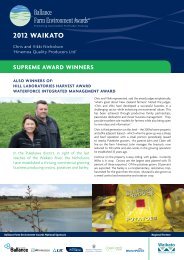Dairy's role in sustaining New Zealand - Fonterra
Dairy's role in sustaining New Zealand - Fonterra
Dairy's role in sustaining New Zealand - Fonterra
Create successful ePaper yourself
Turn your PDF publications into a flip-book with our unique Google optimized e-Paper software.
4 Dairy’s <strong>role</strong> <strong>in</strong> generat<strong>in</strong>g growth<br />
Export growth has been driven by a comb<strong>in</strong>ation of strong global <strong>in</strong>come growth for the<br />
majority of the decade, as well as a change <strong>in</strong> the composition of the markets that we sell to.<br />
As economies such as Ch<strong>in</strong>a and other parts of Asia experience higher liv<strong>in</strong>g standards, their<br />
tastes and preferences change, and staples such as rice, lentil and beans are replaced with<br />
higher prote<strong>in</strong> foods. The chang<strong>in</strong>g composition of <strong>New</strong> <strong>Zealand</strong>’s dairy markets is shown<br />
<strong>in</strong> Figure 13 <strong>in</strong> Appendix G. Ch<strong>in</strong>a, for example, accounted for 0.4% of <strong>New</strong> <strong>Zealand</strong>’s dairy<br />
exports <strong>in</strong> 1989 and now takes over 12%. The relative importance of major markets such as<br />
the UK, Japan and Mexico has dropped over this period.<br />
1.5 Contribution to Balance of Payments<br />
The strong export growth from the dairy sector has been a key factor <strong>in</strong> <strong>New</strong> <strong>Zealand</strong>’s<br />
current account deficit (CAD) narrow<strong>in</strong>g <strong>in</strong> recent years. This is important because as the CAD<br />
rises as a proportion of GDP, foreign <strong>in</strong>vestors and rat<strong>in</strong>gs agencies start to have concerns<br />
over the ability of the <strong>New</strong> <strong>Zealand</strong> economy to withstand any unexpected negative<br />
economic shock (such as a global pandemic or f<strong>in</strong>ancial crisis). These concerns translate <strong>in</strong>to<br />
<strong>New</strong> <strong>Zealand</strong> hav<strong>in</strong>g a higher risk premium attached to it on foreign borrow<strong>in</strong>gs – that is, it<br />
becomes more expensive for <strong>New</strong> <strong>Zealand</strong> firms, households and the government to borrow<br />
on <strong>in</strong>ternational markets. The most obvious channel would be through higher household<br />
mortgage repayments.<br />
The strength of the dairy sector has been very evident as <strong>New</strong> <strong>Zealand</strong> recovers from the<br />
global f<strong>in</strong>ancial crisis and domestic recession. With domestic demand cont<strong>in</strong>u<strong>in</strong>g to be<br />
anaemic, it is the export side of the economy that is be<strong>in</strong>g relied on to generate economic<br />
growth. It has recently been noted that dairy’s growth has resulted <strong>in</strong> <strong>New</strong> <strong>Zealand</strong>’s trade<br />
surplus be<strong>in</strong>g at its highest level for eight years.<br />
1.6 Contribution to employment<br />
National<br />
The dairy sector <strong>in</strong> <strong>New</strong> <strong>Zealand</strong> is a major employer, and is vital for a number of districts.<br />
On-farm employment is around 24,000 nationwide, with dairy process<strong>in</strong>g provid<strong>in</strong>g another<br />
10,000 jobs. These figures do not <strong>in</strong>clude those dairy farmers who are registered as selfemployed.<br />
Although dairy employment does not reach the employment levels present <strong>in</strong> a number of<br />
services sectors (for example, there are 110,000 workers <strong>in</strong> pre-school and school education<br />
alone), it provides more jobs than each of the f<strong>in</strong>ance and accommodation sectors (both<br />
around 32,000); around 65% more than the sheep and beef farm<strong>in</strong>g sector (20,500); 75% more<br />
than the fruit grow<strong>in</strong>g sector (19,300) and double the jobs <strong>in</strong> the wood process<strong>in</strong>g sector.<br />
Regional<br />
In districts such as South Taranaki, Waimate, Otorohanga and Matamata-Piako, the dairy sector<br />
directly accounts for between 1 <strong>in</strong> 4 and 1 <strong>in</strong> 5 of the total number of jobs <strong>in</strong> the region.<br />
The sector will <strong>in</strong>directly support many more jobs <strong>in</strong> <strong>in</strong>dustries that supply dairy, and that<br />
experience the benefits of additional <strong>in</strong>come flow<strong>in</strong>g <strong>in</strong>to the region due to dairy volume<br />
and/or price growth.<br />
4. Department of Labour (DoL), ‘Regional Industry Tool 2009’http://www.dol.govt.nz/services/LMI/tools/regional-<strong>in</strong>dustry-tool.asp<br />
5. There is no official count of self-employed dairy farmers, but the figure has been estimated by Dairy NZ at around 10,000 based on<br />
owner-operator and sharemilker numbers.
















